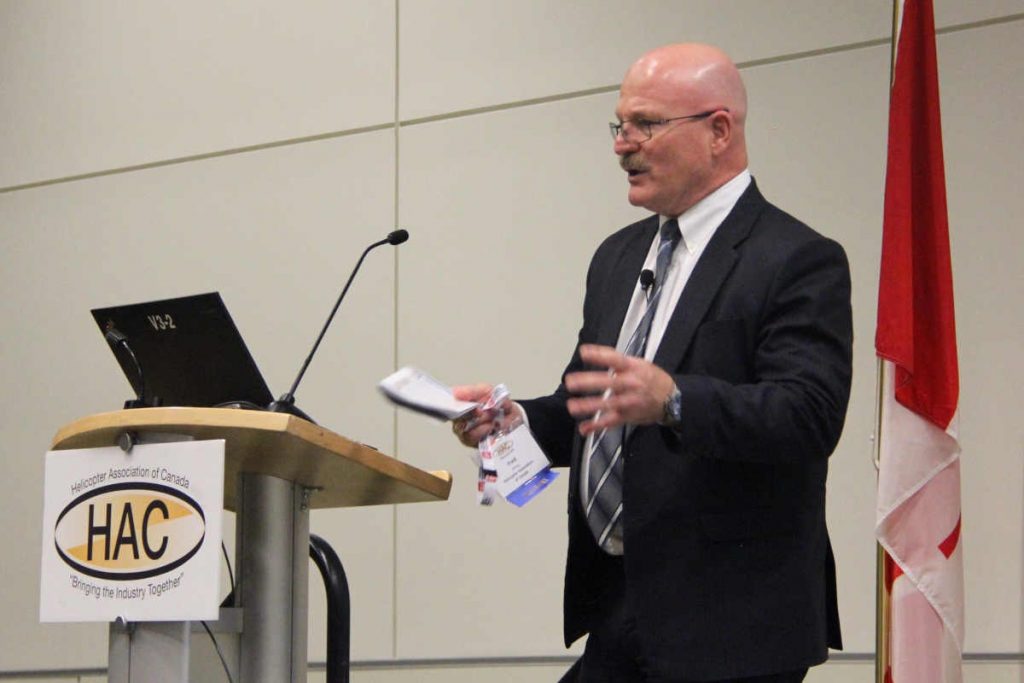
News
Challenges of F&DT update
January 21, 2019 By Fred Jones
On December 12, 2018, after a long and acrimonious debate with industry, Transport Canada published new Flight and Duty Time Regulations in Canada Gazette II. They come into force for airline operators on December 12, 2020; and for Air Taxi and Commuter operators on December 12, 2022.
 Fred Jones speaking at HAC's conference in 2019.
Fred Jones speaking at HAC's conference in 2019. Aerial Work operators will be excluded from the application of the new regulations, however, don’t get too excited – we’re in an industry that switches between CAR 702 and CAR 703 multiple times in the same day. Clearly, if you operate your aircraft in a CAR 703 operation, even if that amounts to just one flight, you would be constrained by the new, more conservative limits. The new regulations will be problematic for all commercial air operators, many already struggling with a shortage of experienced drivers. But they are particularly damning for Canada’s commercial helicopter community. Here are some of the major reasons why:
- Transport Canada has deleted the “zeroing provisions”, which allowed flight crew members to erase accumulated flight time after five days off. The proposition that consecutive days free from duty eliminates fatigue is grounded in the fatigue-related science, and has been used for 15 years. What’s more, if Transport Canada insists on Cumulative Duty Hour regulations then Cumulative Duty Hours should be zeroed, too;
- New Time Free from Duty Provisions require 36 hours off in seven days, and three days off in 17 days. This eliminates the potential for a pilot to provide continuous service to a camp for more than six days, consecutively. As a result, operators will provide shorter periods of time-off in camp, rather than more extended periods of time-off at home;
- Tour Lengths will likely be reduced to 14 days, from a maximum of 42 days – industry norm is roughly 21 to 28 days;
- New Cumulative Duty Hour Limitations will limit the Duty Day to 70 hours in any seven consecutive days (with conditions);
- New Flight Time Limits are considerably more conservative than the current rules – down from 150 hours in 30 days in the current rules to 120 hours; and down from 450 hours in 90 days in the current rules to 300 hours. A single pilot is limited to eight hours flying in any 24 hours; and
- The Maximum Duty Day has been reduced to 13 hours – and only if it starts after 7am.
Transport Canada has included new provisions for Fatigue Risk Management Systems (FRMS), which are intended to provide operators with a way to find relief from the prescriptive regulations – if they can prove that they are able to provide an alternative means of compliance that is not more fatiguing. The system is great, in theory. It remains to be seen whether Transport Canada can come up with standards for approving an FRMS that are scalable for the size and complexity of a small operator. Transport Canada has been working for more than 15 years to develop SMS regulations that are scalable for CAR 703 and CAR 704 operators, so HAC has some doubts. What’s more, let’s remember, part of the promise of SMS was that it was supposed to provide operators with some relief from the prescriptive regulations, where the operator is able to demonstrate an equivalent level of safety. The reality is, that even for airports, airlines and Air Navigation Service Providers (ANSPs), who are required to have an SMS, industry proposals for relief from the prescriptive rules are rarely approved.
Where to, from here? HAC and others are not done attacking the new regulations. In some ways, they are more conservative than draft regulations published in Canada Gazette I on July 1 2017 – something that should not have occurred. How could industry have possibly commented on the impact of these changes, made during a phase of the regulatory process, where there is no opportunity for consultation? These changes affected validity of the Regulatory Impact Analysis Statement, which, we believe was seriously flawed the first time it was conducted. We also believe there are some segment-specific changes to the regulations which should occur in the form of exemptions, because some parts of the regulations are simply not supported by science.
Finally, if certain particularly damaging elements of the new regulations survive these challenges, then our industry – through HAC or company-specific applications, must apply for FRMS relief. These regulations in their current form will be a tremendous hardship for our industry segment, and will cause some businesses to fail. Our customers, particularly in northern and remote communities, will undoubtedly face higher rates and reduced services. | H
Fred Jones is CEO of the Helicopter Association of Canada.